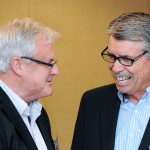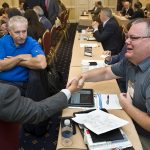The third Finished Vehicle Logistics Import Export summit revealed the need among vehicle-handling ports for more investment in space, berths and inland transport, at the same time that OEMs and logistics partners need to work together to improve the uneven flow of vehicles that 'vessel bunching' and larger ships are causing. Christopher Ludwig and Marcus Williams report from Baltimore, Maryland

[sta_anchor id="1"]The growth of the North American vehicle industry has put port and terminal infrastructure to the test. Not only have car sales across the US, Canada and Mexico reached record levels, but so too has vehicle assembly – rising to 17.5m light vehicles last year and forecast to reach almost 20m by 2022, according to PwC Autofacts.
This rise has certainly been felt in ports. Last year, US gateways handled 10.1m tonnes of vehicles, according to Michael Rodriguez, deputy administrator of the US Maritime Administration, or Marad, a division of the US Department of Transportation. The trade was made across 2,900 ro-ro ships that made 7,065 port calls at the 40 ports in the US equipped to handle vehicle traffic.
Last year saw a particular rise in vehicle imports across the US, Canada and Mexico, meanwhile, according to Finished Vehicle Logistics' 2015 Port Survey.
According to Rodriguez, ports must be properly networked, both inland and to global trade, with long-term commitments to that investment. “The name of the game is infrastructure,” he said.
However, there are many questions over whether investment in maritime infrastructure in North America is keeping up with demand, including for the automotive industry. Susan Monteverde, vice-president of government relations at the American Association of Port Authorities (AAPA), which represents 140 ports across the US, Canada and Mexico, said that one in three ports in the US needed at least $100m in intermodal upgrades.
In this report...
“We are excited about the focus [the Fast Act] has put on the maritime mode,” he said. “We don't have enough investment in our infrastructure overall and not enough in our maritime infrastructure, but it is getting a lot of attention from the current administration and in Congress, more than it has in the past. The trend is going in our direction. As we wrestle even more with our congestion issues more people are looking at maritime as a solution.”
It’s not just the port, it’s the peopleFor finished vehicle shipping, however, investment in port infrastructure is not necessarily the simplest answer to its operational challenges. Despite the growth in the industry, regional production in North America has grown at a faster rate than vehicle imports and exports for many manufacturers, with some volumes from traditional sources like Japan, South Korea and Europe shifting to plants in the US and Mexico – a trend that may continue more markedly in coming years.
Volume, therefore, is not the only factor. Instead, issues such as increasing vessel size and bunched arrival times have caused capacity pressures, leading to slower operations and crowded port yards that make it difficult for carmakers and terminal operators to balance labour and quality demands.
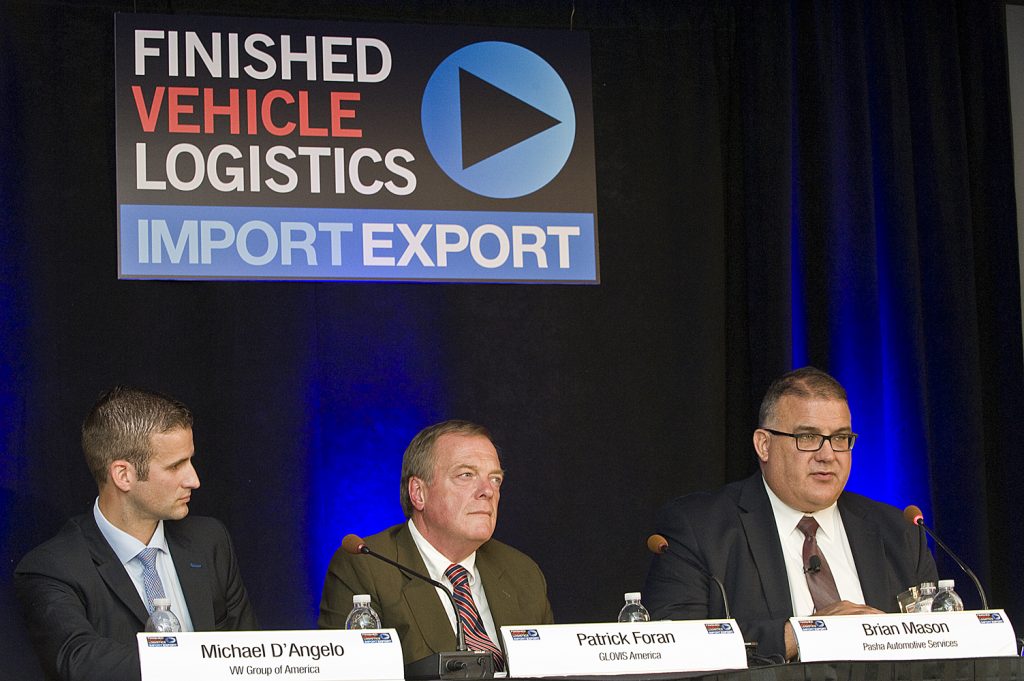 Pasha's Brian Mason (right) said that large vessels making shipments a few days apart could quickly fill up port yard capacity
Pasha's Brian Mason (right) said that large vessels making shipments a few days apart could quickly fill up port yard capacityBrian Mason, vice-president of planning, analysis and development at Pasha Automotive Services, which runs a major vehicle terminal at the port of San Diego, California as well as other US locations, said that vessels used to drop 400-500 units per port call, while today it is more common to see vessels discharging 1,500-2,000 units at a time, often arriving within several days of each other.
“With larger ro-ro vessels coming in one after another, they are really filling up our ‘first point of rest’ area for cars,” he said. “That means it is taking longer to process the vehicles and get them on rail and truck.
“In some cases, it could mean that a ship gets stuck at the berth while we find space to unload the cars. That is what we are starting to get into at terminals,” he added.
Other logistics executives also pointed to the challenges of managing labour supply and quality across peaks and troughs, difficulties that in some ways matter more than physical infrastructure and available space at some ports.
Bryan Burke, department head for national vehicle distribution at BMW North America, said the carmaker had mostly invested in its own port terminals, whether through leases or owning the property, and had designed and built them to its own specifications. Although each currently used some form of external storage, most were working well in terms of space and capacity, he said. His top concern, on the other hand, was the availability of labour, and keeping steady work for qualified employees handling BMW paintwork, modifications, accessories and repairs.
“We need to help logistics providers to find a way to keep the people there, as it is a waste of time if you are constantly retraining new people.”
The issue was similar for General Motors, according to Alfonso Rodriguez, manager of operations for North America and intercontinental vehicle logistics, including for its export shipments from the US via the west coast. Following long transport lead times from a plant in the Midwest, for example, sometimes vehicles require repair and maintenance at the port, which without skilled labour available can lead to cars missing a sailing. The situation was similar for imports arriving from Asia, he said, where a lack of skilled labour for necessary repairs on the west coast could also sometimes lead to delays.
Jerry Schoenle, director of Ford Trading Company Emerging Market Services, a Ford division looking after port and shipping services for the carmaker, said that technical capabilities and modifications among port processors were also very important for Ford. The carmaker has also faced labour issues during peak delivery periods.
“Having capacity available is important, but we don’t want the bad behaviour that comes with excess capacity,” said Schoenle. “We are looking at how we can have faster throughput and become more efficient with our partners. Having restricted capacity can help drive that.”
Schoenle and Rodriguez pointed to peak delivery periods, such as the end of each month or quarter or year, that particularly strained labour resources. Burke said nearly half of BMW’s annual sales in the US came during the last quarter of the year.
[sta_anchor id="2"]Follow the money to shoreFor North American ports, then, there are questions over how to both secure the right funding and investment for port investment – resources which are sorely needed, especially in Mexico but also across ageing ports in the US – and balance that with the most efficient processes and communication to help improve vehicle flows.
Neither of these twin challenges is easy. Many of the car industry’s inefficiencies are built into the sector one way or another, whether it is end of month or quarter sales pushes, or production schedules optimised for plant and supplier constraints rather than rail or shipping schedules. Changing that requires cultural shifts across companies and the industry – something for which vehicle logistics is not always influential enough.
Developing better port infrastructure, on the other hand, is just hugely expensive. For one thing, ro-ro ports need to compete over precious few resources compared to containers, tankers and even tourism. For example, ports are often in close proximity to urban centres and need to compete for land with other property development. Susan Monteverde pointed out that port developers have to make the best use of the land at their disposal while being sensitive to population centres, including to the impact of congestion and emissions from trucks feeding their ports. They also need to take into account connecting bridges that may span the channels ships use to get into port, especially given the trend in shipbuilding for bigger post-Panamax vessels.
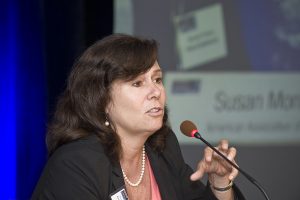 AAPA's Susan Monteverde said that US ports needed around $100m each of intermodal investment to improve links
AAPA's Susan Monteverde said that US ports needed around $100m each of intermodal investment to improve links“You have to consider whether you can get large ships in,” said Monteverde. “The port of Baltimore can, even the big box carriers, but car carriers are going to get bigger too and you need to plan for that. That may also require the deepening of the channels.”
There are also different operating structures to think about to avoid congestion when carmakers move their product. She said port developers had to look at velocity and how to manage it.
“Customers could leave the port if it is too busy,” she warned. “The port authorities have an umbrella view of what is happening and it is necessary to talk to all parties working in and out of the port. That includes good communication with stakeholders to find a solution. Landlords are becoming more involved in the supply chain.”
Michael Rodriguez admitted that the flow of dollars to ports might be slow from the state but stressed that the DoT had been directing investment into the nation's vehicle handling ports, including through so-called TIGER grants (Transportation Investment Generating Economic Recovery), of which vehicle-handling ports such as Baltimore have received several.
“In recent years we have allocated hundreds of millions of dollars in multimodal port projects across the nation,” he said, noting that $706m had been matched with $960m in regional and private partner commitments to build $1.6 billion worth of intermodal port infrastructure projects. He added that the long-term commitment to investment went toward the security and prosperity of the nation.
Along with the TIGER programme, which was initially set up by the Obama administration as part of the US economic stimulus package after the financial crisis, funding for these projects is available through FAST, which includes $11 billion of available funding for freight mobility that is guaranteed into the next administration.
The DoT's Maritime Administration also has an initiative called Strong Ports, which helps smaller ports that may not have the capacity or staff to put together project planning and development. Through the programme it takes care of that and helps look for financing, as well as monitoring the progress of the project once underway.
“We also have the Building America Bureau providing interested parties with information and help in getting through the regulatory processes, looking for financing, just about everything you need,” said Rodriguez. “It is a one-stop shop.”
 Michael Rodriguez from the Maritime Administration said that the FAST act had helped secure more long-term funding for ports
Michael Rodriguez from the Maritime Administration said that the FAST act had helped secure more long-term funding for portsHowever, despite these initiatives, not everyone is convinced that port investment is keeping pace with provision for other modes and some felt that the federal budget was distinctly lacking. TIGER funding has allotted $600m to 52 port-related projects, allocated over eight rounds, but demand for the funds far exceeds what is available.
The $960m in private regional investment quoted by Rodriguez will have to be stepped up because federal funding is falling short, even after the passing of the FAST Act. Monteverde suggested federal funds were not keeping pace with demand in part because ports had to vie for funding from the government spend with highways and air transport. “The highway money is the big kahuna in federal spending,” she said.
The good news, however, is that ports are stepping up their overall investment, including through private funding. In a survey of members across the US, the AAPA found that seaports were planning to invest $155 billion over the next five years – three times the amount five years ago, when members were last surveyed. “They are planning on going on a spending spree to address some of these infrastructure needs,” she said.
Rodriguez maintained that increasing investment and focus on ports was urgent to keep US ports competitive and secure. “The stakes could not be more urgent. The future is here and if we work together, collaborate, create and invest, we can contribute to an economic renaissance in multimodal transportation that can lead the world,” he said.
[sta_anchor id="3" class="3"]Space to turn in terminalsLogistics executives at carmakers certainly recognised the problem of space and port capacity and pointed to the need to procure enough space and design it effectively to handle a given operation based on transport and volume requirements. Michael D’Angelo, port manager at Davisville, Rhode Island for the Volkswagen Group of America, pointed to the increasing trend toward large ship sizes and said it was only going to continue following the recent expansion of the Panama Canal.
“Larger vessels are putting pressure on port processors, carriers and dealers, with arrival activity that looks like an EKG [heart rate] monitor,” he told delegates at the conference. “Many need to make adjustments to manage that – if our processors and carriers don't scale, then bottlenecks will occur in ports and railheads.”
There are certainly automotive ports that have been investing heavily to keep up with such trends. The port of Baltimore, the leading vehicle handling port in the US, is a good example of one that is investing to keep pace with demand through both public and private means. It is a landlord port, meaning that it secures its own terminals and builds and maintains its own infrastructure – including dredging the channels into the port which by itself costs it $60m a year, according to Rick Powers, director of marketing at the Maryland Port Administration.
Baltimore is paying an equal amount for the reconstruction of several berths at its 575 acre (233 hectare) Dundalk Marine Terminal, as well as investing $13m in drainage improvements. This work follows $22m spent in berth improvements at the Fairfield/Masonville terminal, $5m of which was dedicated to enabling ocean vessels to drop their stern ramps closer to the port processor in an effort to increase velocity.
 According to Rick Powers (centre) from the Maryland Port Administration, the port of Baltimore spends around $60m each year alone on dredging projects
According to Rick Powers (centre) from the Maryland Port Administration, the port of Baltimore spends around $60m each year alone on dredging projects“We are making improvements to help OEMs move their product faster and damage-free,” said Powers. “All investment is big and we have made a lot already. For containers, we have also switched to lease concession. This keeps the port modernised because private investment can move faster than state investment. We are now investing in development for high-and-heavy traffic. We need more land but our investment is paying off.”
Vehicle processing operations do not just depend on port investment but also the space and design of yards operated by carmakers and port processors. Pat Foran, operations support manager at Glovis America, the logistics arm of Hyundai and Kia, emphasised the importance of yard design at plants and ports. He pointed to the careful calculations for truck spaces, railcar and locomotive operations that Glovis made when planning its yards, including at the port of Philadelphia which handles about 160,000 cars per year for the Korean brands, as well as at Hyundai’s plant in Montgomery, Alabama; and Kia’s plants in West Point, Georgia and in Nuevo Leon, Mexico, which began mass production in June.
“For example, you have to consider whether you have bi-level or tri-level railcars, or both,” he said. “At Hyundai’s Montgomery plant, we ship only tri-levels, serving two rail destinations in Mexico, eight in Canada and 16 in the US.
“However, if you have both tri-levels and bi-levels, as Kia does in West Point, you double the number of active load lines you need to fill up rail cars efficiently.”
Foran also pointed to the importance of having enough space for truck carriers to load and unload and to provide a safe turning radius.
“Port property costs money, but not getting your car to the marketplace can cost more money,” he said. “You need to make it work for everyone. Truck carriers need enough room to move in, turn and stage. For rail, you need to think about where switching is, where is the locomotive is, chock equipment, etc.”
[sta_anchor id="4" class="4"]Finding the right flowExecutives at the conference also highlighted ways to mitigate the effects on labour and productivity from vessel bunching and uneven flows beyond simply trying to acquire more space. Some of these solutions included more sophisticated integration of production and shipping schedules, or using technology to better communicate pickup and load allocation electronically.
For example, some carmakers are trying to better align production schedules for exports with shipping. Global exporters such as BMW have trialled and implemented aspects of this approach already, while Ford’s Jerry Schoenle revealed that the carmaker was currently looking to introduce such a process for export-orientated plants in Asia.
“Trying to coordinate our schedules to build F-150 pickup trucks for a train scheduled to a particular destination in California, for example, is currently too complicated,” he said. “But if you have plants, as we do in Asia [such as in Thailand], that build mainly for export and are only a few hours away from the port, that is a great model to apply what we call ‘build to ship’.”
In this level of planning, production schedules would be based, in part, on shipping services and on destination markets for exports. Schoenle said the approach was still under development but would be deployed first in Asia. Read more about Ford's vehicle logistics in Asia Pacific here.Rodriguez pointed out that GM was also making efforts to level its production schedules for export, as ports at some destination markets were also complaining of similar bunching and large volume unloading. He encouraged others in the industry to work together on such a rebalancing. “We need to coordinate as an industry to level out shipments to avoid massive loading and unloading,” he said.
Executives also pointed to the importance of systems visibility and interfaces, such as having electronic data exchanges and global distribution systems to coordinate flows across regions. Schoenle said Ford was evolving from being a highly regionalised organisation, with relatively few exchanges of vehicles and information between them, to one in which global exports could reach 1m units over coming years.
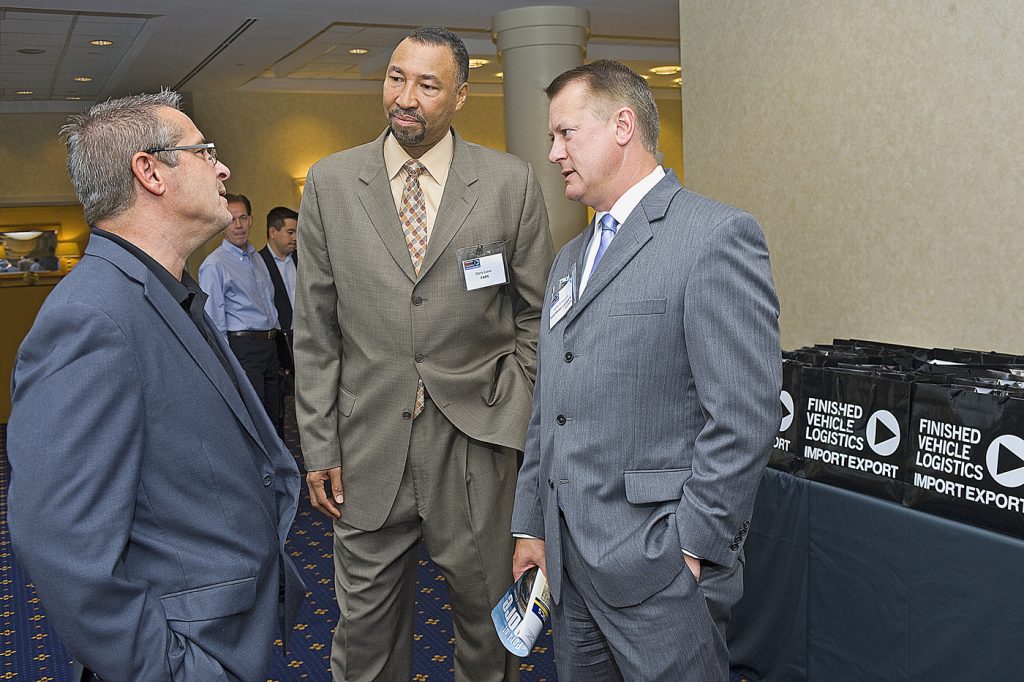 Ford's Jerry Schoenle (right) said that the company was making large investments to improve its internal systems to better link its global organisation and support increased exports
Ford's Jerry Schoenle (right) said that the company was making large investments to improve its internal systems to better link its global organisation and support increased exports“It is a huge internal investment to build that international team and visibility across continents,” he said. “We want to share information but also get it from providers, too, and connect it across our distribution systems.”
Alfonso Rodriguez said GM was investing further in tools for tracking and tracing global vehicle flows, meanwhile.
Carmaker executives at the conference pointed to the potential for current and evolving technologies to help improve this communication, from having basic EDI capabilities and barcode scanning to the potential of RFID to help automate vehicle tracking and management at port terminals. Carmakers including BMW, GM and Ford also pointed to their vehicles’ on-board infotainment and connectivity systems as new tools to track vehicles.
According to Burke, BMW is about one year away from deploying the telematics in its vehicles as a tool to track locations anywhere in the world. “I don’t think it is going to replace barcode scanning and other tracking, but it will be another tool at our disposal,” he said.
Getting priorities in orderAt the heart of any solution to manage inconsistent vessel arrivals and higher inventory levels at ports, however, is the need for better communication across the supply chain – regardless of whether it is through high-tech or low-tech means.
Pasha’s Brian Mason, for example, pointed out that while a flurry of several vessels arriving at San Diego had recently led to 9,130 units arriving in just three or four days – equating to 41% of the port’s parking capacity – the port was capable of handling such volume; it would just be more efficient to spread out the arrivals. Mason pointed out that simply by tracking and updating vessels’ sailing and arrival schedules, and keeping close dialogue with shipping companies, “win-win solutions” could be found by “metering” the incoming ships and creating a more even flow.
“For example, if we learn that a ship is sailing several days ahead of schedule, we might be able to agree that the ship can slow down, save fuel and arrive on time,” he said. “We may be able to get agreement from OEMs on board about a ship’s later arrival as well, especially if it is not near month’s end.”
BMW’s Bryan Burke agreed that communication with shipping, port and transport providers helped deal with volume variations. When ships start to bunch up, he said, BMW’s logistics team needed to speak with its sales department to determine what the most important priorities were.
“There is no magic bullet but if you communicate, you can learn what you can do,” he said. “For example, we have a priority system and those vehicles that are assigned to customers and should move first are designated directly off the vessel.”
According to Rodriguez, GM also knows exactly which vehicles are prioritised for faster unloading and plans ahead with extra transport capacity where necessary to handle bunching of vehicles.
[sta_anchor id="5" class="5"]Don’t overstay your welcomeAnother area where carmakers might help improve flows through ports is through faster or more consistent vehicle allocation. Mason, who previously worked for more than 30 years with Toyota, said he would prefer the Japanese idea of a “smooth heijunka flow” through ports. However, many vehicles arrived unassigned and spent long periods at port yards prior to being allocated to dealers – a trend Pasha has noted among a number of carmakers and brands, he said.
“If vehicles are all assigned to dealers, we can process them in five days. But when we get 3,000, all unassigned, then they sit and sit,” said Mason.
Mason added that Pasha and other processors made money on static inventory, including on maintenance work and further handling. However, he asserted that it was is not the kind of business the company wanted, especially as it required overtime labour and offsite yard space – extra costs which it could not bill back to OEMs.
“We prefer a good flow of cars. Some of our most profitable months are actually those in which volume is lower, but steady, compared to high volume months where our profit margin has been much lower,” he said.
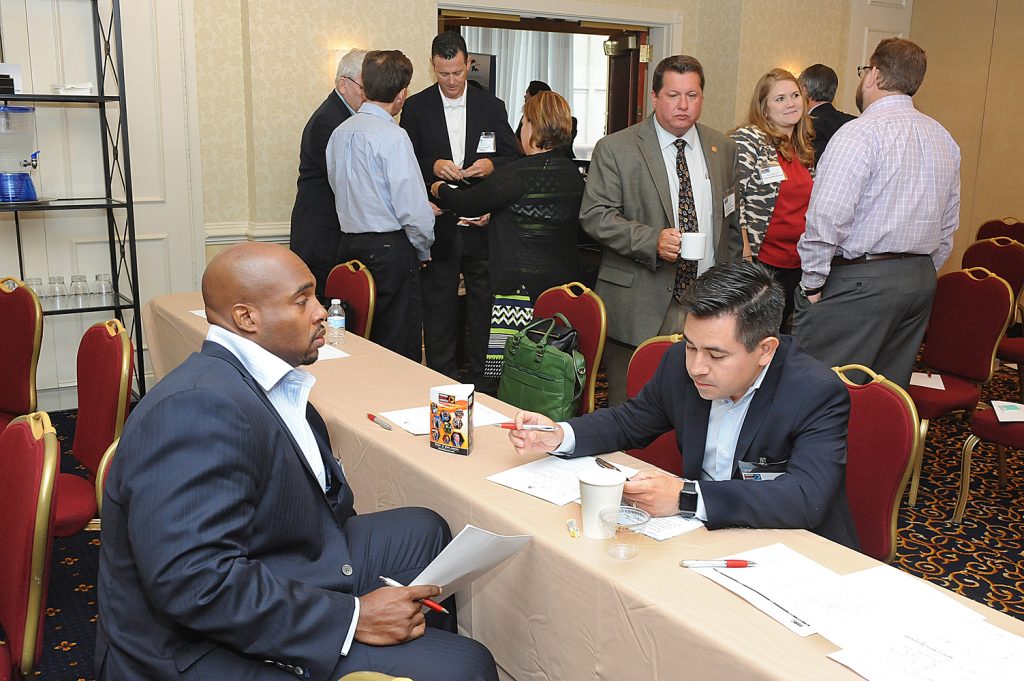 Alfonso Rodriguez (seated right) said that GM was working on levelling its production for exports to help relieve overcrowding in ports
Alfonso Rodriguez (seated right) said that GM was working on levelling its production for exports to help relieve overcrowding in portsSome OEMs and dealers, he suggested, were using the port yard as an external storage area to pull from as sales were made – something he thinks has resulted from some companies’ failure to expand their own facilities as sales reached record levels. He pointed to the example of vehicles destined for Hawaii, which in some cases were arriving at San Diego up to a month before scheduled sailings.
“It’s too long – we would rather they arrived about two weeks before so that we could stage them and build a more even flow,” he said.
There are OEMs that have moved away from leaving cars unassigned to dealers, at least for what they build in North America. Every vehicle that GM builds, for example, has an assigned buyer or destination, according to Rodriguez, which has helped it to avoid extra checks or keeping vehicles for too long at ports for export.
While there are examples of carmakers whose inventory may have piled up as a result of a market slowdown or a failure to bring production in line with demand, Mason and others did not think that port yard inventory was a sign of a pending downturn, in the way that ports saw in the run-up and aftermath of the financial crisis in 2008. Nor did Mason think it was a sign that OEMs had returned to the ‘push’ production model that preceded that time. He said such incidents were isolated rather than systematic, whether it might be OEMs with more sedans sitting during a time when SUVs and crossovers were selling faster, or in some cases OEMs dealing with recall issues or safety holds. In many cases, it was also a question of seasonality, including model-year changeovers and launches, or recovery after summer shutdown periods.
Pat Foran at Glovis, whose customers Hyundai and Kia have traditionally carried higher inventory levels than competitors, suggested it was “presumptuous” for those outside a particular carmaker to think of higher inventory as a problem at a port or plant yard – which Foran prefers to call a “vehicle warehouse” – when it could often be a seasonal or strategic decision.
“Sometimes our vehicle warehouse gets thin and sometimes it holds more cars. Seasonality plays into it, or model mix or launches,” he said. “It comes down to a matter of communication and coordination with service providers to address when we need extra or less warehouse space.”
[sta_anchor id="6" class="6"]Expanding optionsWith vehicle processing and volume through ports at healthy levels for many manufacturers, they are interested in adding more port options. Both BMW and GM have recently started using new port terminals in Texas, on the Gulf coast, with BMW adding a new WWL terminal in Galveston and GM using a Höegh-run terminal in Freeport. Schoenle said Ford was also exploring options in the Gulf, as well as other locations. FCA also told Finished Vehicle Logistics earlier this year that it was considering an anchor port in the Gulf as well.
BMW’s Burke added that the carmaker was also already looking at options for adding a sixth US entry point, following the ports of New Jersey, Baltimore and Brunswick, Georgia on the east coast, Galveston as well its current terminal in southern California in Hueneme. “We have outgrown our capacity in Hueneme and so we are looking at another west coast port option,” he revealed.
 Pasha is opening new vehicle terminals in both the port of San Fransisco and at a new development at Sparrows Point in Baltimore
Pasha is opening new vehicle terminals in both the port of San Fransisco and at a new development at Sparrows Point in BaltimorePasha is currently involved in launching and developing terminals at two new locations. One is at Pier 80 at the port of San Francisco, California, which will have 70 acres available off the docks, plus an extra 45 acres offsite. The first shipment is expected to arrive later in August.
In Baltimore, meanwhile, Pasha has been working with Tradepoint Atlantic to develop part of the former steel factory at Sparrows Point into a new vehicle terminal. The terminal, which is a private investment not owned or managed by the Maryland Port Authority, will be developed across three phases to 200 acres. The first 22 acres have already been paved and vessels began arriving for Fiat Chrysler in June.
“There is really nothing like this site on the east coast, as it is 3,000 acres in total and has 100 miles (160km) of rail track on it,” said Mason. “We have dual rail access for Norfolk Southern and CSX, which will be built as part of the second and third phase.”
According to Mason, interest in these two sites has meant they have filled up faster than expected. “That includes more and more interest in short-sea options from Mexico, but also traditional traffic from Asia and Europe,” he said.
[sta_anchor id="7" class="7"]Mexican momentumMexico’s continued and anticipated growth remains one of the main drivers of activity and change across vehicle-handling ports and shipping, including an increase in deep and short-sea trade for Mexico. Car assembly there has grown by 50% over the last five years to 3.4m units and is expected to grow by around 47% over the next five years to reach almost 5m, according to analyst Terese-An Nguyen from PwC Autofacts. As a consequence there is now a lot of pressure on transport in and out of the country.
According to figures compiled by PwC and Kansas City Southern (KCS), 82% of the vehicles made in Mexico last year (2.76m) were for export, with 85% of that figure going to the US and Canada (2.53m). Cross-border rail accounts for up 87% of vehicle traffic going north to the US and Canada. Mexico has two main providers, KCS Mexico and Ferromex, both of which are aggressively investing to add capacity against forecasts of more than 3m vehicles being exported by rail over the next five years. However, securing a rail service is not just about land and passage rights, it is also about winning local approval and investing in the communities affected by the rail lines.
 PwC's Terese-An Nguyen predicted that short-sea from Mexico would grow as exports from the country increased
PwC's Terese-An Nguyen predicted that short-sea from Mexico would grow as exports from the country increasedRailways have asserted that they are investing in enough capacity to maintain or exceed their current share of US and Canada-bound exports from Mexico. Even if they are, short-sea shipping is still set to grow to almost 450,000 vehicle unit exports by 2020, up from 306,000 last year, according to PwC’s Nguyen.
However, the interest among carmakers in diversifying their shipping options is clear, and could lead to even more shipping. This year, as Audi starts production at a new plant in the state of Puebla, for example, it is using short-sea to export from the port of Veracruz on the Gulf coast together with Volkswagen production; Audi has also revealed that it is interested in using Lázaro Cardenas on the Pacific coast to export by short-sea to the west coast, where it would join other carmakers such as Honda.
Carmakers are exploring these options partly out of concern that railways will lack adequate capacity to handle growth. However, there is also increasing concern over damage and vandalism affecting vehicles travelling by rail northbound.
“Damage is increasing, particularly in the north-west of the country,” said GM’s Rodriguez, a Mexican native who led outbound logistics in the country for GM before taking on his current assignment earlier this year. “We do consider those damage rates when making decisions between using rail and short-sea.”
Rodriguez said GM’s split between rail and sea was close to the industry average quoted by PwC, but that the carmaker was using and exploring new options. “We have been among the only ones using Altamira for exports, while we also want to keep our foothold in Veracruz,” he said. “Lázaro is big and would likely be able to handle more volume. We are also looking at the [east coast] port of Tuxpan, but need to make sure it has adequate inland connections.”
Schoenle indicated that Ford’s current split between rail and ocean was also still heavily weighted toward rail, although the carmaker used regular services to the US east coast. However, he explained that a recent decision by Ford to use the port of Mazatlan, on the west coast, to export vehicles to China via the US was influenced by damage rates. Previously, models of the Lincoln MKZ built in Hermosillo, in north-west Mexico, moved by rail to Portland, Oregon, where they joined other Ford exports to China. However, increasing damage by rail, along with other cost issues, led the carmaker to consider a sea route.
“That decision was based at least 50% on the damage levels,” he said.
Initially, Ford started using a service moving vehicles from Mazatlan to Portland by sea to join other China-bound exports. More recently, it started shipping directly to China from Mexico. It is also exploring shipments from the port to the US for domestic distribution.
By sea and by landBoth BMW and Ford will build new plants in Mexico in the city of San Luis Potosi, slated to open later this decade; GM also has a plant in the city nearby that it will expand. The location has good rail access, but carmakers are exploring all options. Bryan Burke said his team was currently working with the carmaker’s central logistics management in Germany to decide on the routes it would use from the plant to the US.
“I think we will probably use a mix of short-sea options along with rail to west coast destinations,” he suggested, though he acknowledged this was still being decided.
There are also plenty of questions around the capacity of Mexican ports themselves, including at Veracruz, the country’s largest for vehicles, and at Lázaro, on the west coast. Nguyen said that short-sea to the US east coast was still far more common than on the west coast but that could start to change. “Veracruz has the monopoly at this point but investment into Lázaro Cárdenas will make it an interesting short-sea route all the way up the US west coast between the ports of San Diego and Grays Harbor,” said Nguyen.
When you consider the proximity of BMW, Ford and GM’s plants in San Luis Potosi – all three will be within just a few kilometres of each other – you can see some of the challenges that carmakers may increasingly face in a rush for transport capacity and resources in Mexico. Burke admitted that BMW was worried about investments in Mexican infrastructure, including rail and ports.
GM’s Rodriguez also suggested that investment in Mexico from government wasn’t keeping up with private investment from carmakers and others.
“The pace needs to increase or we will face problems. We hope there is sufficient capacity,” he said. “We have a network design team working on our future moves.”
Ford is also looking at ways to head off trouble down the line. “As Ford increases volumes out of Mexico, we will need options or else be in a bad situation,” added Jerry Schoenle. “We will look at giving ourselves more options.”
The Finished Vehicle Logistics Import Export Conference is part of the global Automotive Logistics series of conferences.
The next conference in the series is Automotive Logistics Global, the signature event in North America, on September 20th-22nd in Detroit.
The next conference dedicated to finished vehicle logistics will take place at a new time in March 2016, in a new location in Huntington Beach, California. More details will be available soon.


































